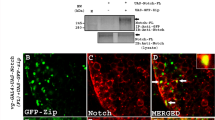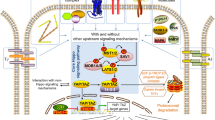Abstract
Adenomatosis polyposis down-regulated 1 (APCDD1) is a transmembrane glycoprotein that negatively regulates Wnt/β-catenin canonical signaling by binding with Wnt ligands and receptors. We analyzed the role of APCDD1 in the Wnt5a/c-Jun non-canonical signaling pathway and demonstrated that APCDD1 can interact in vitro with Wnt5a, a classical ligand, and Ror2, a receptor of non-canonical Wnt signaling. Furthermore, we verified the binding of APCDD1 and Ror2 in primary cells of mouse skin. Moreover, APCDD1 seems to form a complex with Ror2 and Vangl2 in the cell, and complex formation can be improved by adding Wnt5a. In the presence of Wnt5a and Ror2, APCDD1 can induce the phosphorylation of c-Jun, a transcription factor of Wnt5a non-canonical signaling, and its phosphorylation level is a readout of Wnt5a signaling. Wound-healing assay shows that APCDD1 accelerates polarized cell migration during Wnt5a-induced wound closure. Therefore, it is very likely that APCDD1 regulates Wnt5a/c-Jun non-canonical signaling as co-receptor binding with both Wnt5a and Ror2.
Similar content being viewed by others
References
TAKAHASHI M, FUJITA M, FURUKAWA Y, et al. Isolation of a novel human gene, APCDD1, as a direct target of the β-Catenin/T-cell factor 4 complex with probable involvement in colorectal carcinogenesis [J]. Cancer Research, 2002, 62(20): 5651–5656.
JUKKOLA T, SINJUSHINA N, PARTANEN J. Drapc1 expression during mouse embryonic development [J]. Gene Expression Patterns, 2004, 4(6): 755–762.
NEUPANE S, SOHN W J, GWON G J, et al. The role of APCDD1 in epithelial rearrangement in tooth morphogenesis [J]. Histochemistry and Cell Biology, 2015, 144(4): 377–387.
SHIMOMURA Y, AGALLIU D, VONICA A, et al. APCDD1 is a novel Wnt inhibitor mutated in hereditary hypotrichosis simplex [J]. Nature, 2010, 464(7291): 1043–1047.
LEE H K, LAUG D, ZHU W Y, et al. Apcdd1 stimulates oligodendrocyte differentiation after white matter injury [J]. Glia, 2015, 63(10): 1840–1849.
VIALE-BOURONCLE S, KLINGELH ¨OFFER C, ETTL T, et al. The Wnt inhibitor APCDD1 sustains the expression of ß-catenin during the osteogenic differentiation of human dental follicle cells [J]. Biochemical and Biophysical Research Communications, 2015, 457(3): 314–317.
GRUMOLATO L, LIU G Z, MONG P, et al. Canonical and noncanonical Wnts use a common mechanism to activate completely unrelated coreceptors [J]. Genes & Development, 2010, 24(22): 2517–2530.
SATO A, YAMAMOTO H, SAKANE H, et al. Wnt5a regulates distinct signalling pathways by binding to Frizzled2 [J]. The EMBO Journal, 2010, 29(1): 41–54.
GAO B, SONG H, BISHOP K, et al. Wnt signaling gradients establish planar cell polarity by inducing Vangl2 phosphorylation through Ror2 [J]. Developmental Cell, 2011, 20(2): 163–176.
NISHITA M, ENOMOTO M, YAMAGATA K, et al. Cell/tissue-tropic functions of Wnt5a signaling in normal and cancer cells [J]. Trends in Cell Biology, 2010, 20(6): 346–354.
CANEPARO L, HUANG Y L, STAUDT N, et al. Dickkopf-1 regulates gastrulation movements by coordinated modulation of Wnt/ß catenin and Wnt/PCP activities, through interaction with the dally-like homolog knypek [J]. Genes & Development, 2007, 21(4): 465–480.
KAGERMEIER-SCHENK B, WEHNER D, ¨OZHANKIZIL G, et al. Waif1/5T4 inhibits Wnt/ß-catenin signaling and activates noncanonical Wnt pathways by modifying LRP6 subcellular localization [J]. Developmental Cell, 2011, 21(6): 1129–1143.
ANDRE P, WANG Q Y, WANG N, et al. The Wnt coreceptor Ryk regulates Wnt/planar cell polarity by modulating the degradation of the core planar cell polarity component Vangl2 [J]. The Journal of Biological Chemistry, 2012, 287(53): 44518–44525.
ENDO M, NISHITA M, MINAMI Y. Analysis of Wnt/planar cell polarity pathway in cultured cells [J]. Methods in Molecular Biology, 2012, 839: 201–214.
NISHITAM, YOO S K, NOMACHI A, et al. Filopodia formation mediated by receptor tyrosine kinase Ror2 is required for Wnt5a-induced cell migration [J]. The Journal of Cell Biology, 2006, 175(4): 555–562.
NOMACHI A, NISHITAM, INABA D, et al. Receptor tyrosine kinase Ror2 mediates Wnt5a-induced polarized cell migration by activating c-Jun N-terminal kinase via actin-binding protein filamin A [J]. The Journal of Biological Chemistry, 2008, 283(41): 27973–27981.
KURAYOSHI M, OUE N, YAMAMOTO H, et al. Expression of Wnt-5a is correlated with aggressiveness of gastric cancer by stimulating cell migration and invasion [J]. Cancer Research, 2006, 66(21): 10439–10448.
CRUCIAT C M, NIEHRS C. Secreted and transmembrane Wnt inhibitors and activators [J]. Cold Spring Harbor Perspectives Biology, 2013, 5(3): a015081.
QIN W, LIU P C, ZHANG R, et al. JNK MAPK is involved in BMP-2-induced odontoblastic differentiation of human dental pulp cells [J]. Connective Tissue Research, 2014, 55(3): 217–224.
SAMMAR M, SIEBER C, KNAUS P. Biochemical and functional characterization of the Ror2/BRIb receptor complex [J]. Biochemical and Biophysical Research Communications, 2009, 381(1): 1–6.
HU B, LEFORT K, QIU W Y, et al. Control of hair follicle cell fate by underlying mesenchyme through a CSL-Wnt5a-FoxN1 regulatory axis [J]. Genes & Development, 2010, 24(14): 1519–1532.
Author information
Authors and Affiliations
Corresponding author
Additional information
Foundation item: the National Natural Science Foundation of China (Nos. 31671504 and 81421061), the Cross Research Fund of Biomedical Engineering of Shanghai Jiao Tong University (No. YG2016MS04), the Natural Science Foundation of Shanghai (No. 13ZR1421100), and the National Key Technology R&D Program of China (No. 2012BAI01B09)
Rights and permissions
About this article
Cite this article
Wang, L., Tao, Y., Zhang, J. et al. APCDD1 as a Co-receptor Positively Regulates Wnt5a/c-Jun Non-Canonical Signaling Pathway. J. Shanghai Jiaotong Univ. (Sci.) 24, 510–516 (2019). https://doi.org/10.1007/s12204-019-2083-5
Received:
Published:
Issue Date:
DOI: https://doi.org/10.1007/s12204-019-2083-5




